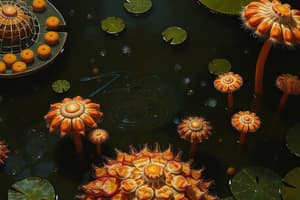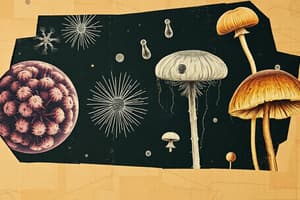Podcast
Questions and Answers
Which of the following are key characteristics of protozoa? (Select all that apply)
Which of the following are key characteristics of protozoa? (Select all that apply)
- They are usually found in freshwater and marine habitats (correct)
- They are multicellular organisms
- They have chlorophyll for photosynthesis
- They are generally colorless (correct)
- They lack cellulose cell walls (correct)
How do protozoa generally feed?
How do protozoa generally feed?
By ingesting particulate materials, usually other cells, by phagocytosis
Protozoa that move by ameboid motion are called ________.
Protozoa that move by ameboid motion are called ________.
Sarcoding
Match the divisions of protozoa with their characteristics:
Match the divisions of protozoa with their characteristics:
Where is the usual habitat of Entamoeba histolytica, a parasitic amoeba?
Where is the usual habitat of Entamoeba histolytica, a parasitic amoeba?
What is the diarrhoeal condition caused by infection with Entamoeba histolytica?
What is the diarrhoeal condition caused by infection with Entamoeba histolytica?
Shelled sarcodines like foraminifera and actinophrys live primarily in freshwater habitats.
Shelled sarcodines like foraminifera and actinophrys live primarily in freshwater habitats.
The shells of foraminifera are usually made of _____________.
The shells of foraminifera are usually made of _____________.
Match the protozoan classes with their corresponding descriptions:
Match the protozoan classes with their corresponding descriptions:
Flashcards are hidden until you start studying
Study Notes
General Characteristics of Protozoa
- Lack cellulose cell walls
- Unicellular eukaryotic microorganisms
- Generally colorless
- Found in freshwater and marine habitats
- Many are parasitic in other animals, including humans
- Feed by ingesting particulate materials through phagocytosis
- Some have a special structure called a gullet to swallow bacterial cells or smaller eukaryotic cells
Motility Mechanisms
- Mechanisms of motility are key characteristics used to divide protozoa into taxonomic groups
- Four main groups: Sarcodina, Mastigophora, Ciliophora, and Apicomplexans
Classification of Protozoa
- Classified into four groups based on morphology and other features: Sarcodina, Mastigophora, Ciliophora, and Apicomplexans
- Sarcodina (The Amoebas)
- Move in an amoeboid fashion
- Include organisms such as Amoeba and foraminifera
- Foraminifera secrete a shell during their vegetative growth or phase
Introduction to Protozoa
- Amoebas are parasites that inhabit the oral cavity and intestinal tract of humans and other vertebrates.
- Entamoeba histolytica is an example of a parasitic amoeba that can cause amoebic dysentery.
Shelled Sarcodines
- Shelled sarcodines, such as foraminifera and actinophrys, are exclusively marine organisms that live in coastal waters.
- Their shells, called tests, are made of calcium carbonate and are usually distinctive for various species.
- The weight of the shells causes them to sink to the bottom of their marine habitats, where they feed on particulate deposits in the sediments.
- The cells are not firmly attached to the tests, allowing them to extend partly out of their shells during feeding.
- Foraminifera shells are resistant to decay and are readily fossilized.
Mastigophora (The Flagellates)
- Members of this group are motile due to the action of flagella.
- While many flagellated protozoa are free-living, some are parasitic in or pathogenic for animals, including humans.
- Trypanosomes are an important group of pathogenic mastigophora that cause serious diseases in humans and vertebrate animals, including African sleeping sickness.
- Trypanosoma gambiense is the species that causes African sleeping sickness, which is transmitted by the Tse tse fly (Glossina species).
- The parasite lives and grows in the bloodstream but later invades the central nervous system, causing inflammation of the brain and spinal cord.
Ciliophora (The Ciliates)
- Ciliates are protozoans that possess cilia in some stages of their life cycles.
- They have two kinds of nuclei: the micronucleus, involved in inheritance and sexual reproduction, and the macronucleus, involved in the production of messenger RNA for cell growth and function.
- Vorticella is a well-known ciliate that is attached to surfaces by a stalk.
- Balantidium is another member of this class.
Apicomplexa
- This group comprises a large number of parasites characterized by the presence of an apical complex, which absorbs food.
- Members of this group are parasites of a wide variety of organisms, including prokaryotes and invertebrates.
- Plasmodium, responsible for malaria, and Toxoplasma gondii are examples of apicomplexa.
Studying That Suits You
Use AI to generate personalized quizzes and flashcards to suit your learning preferences.



